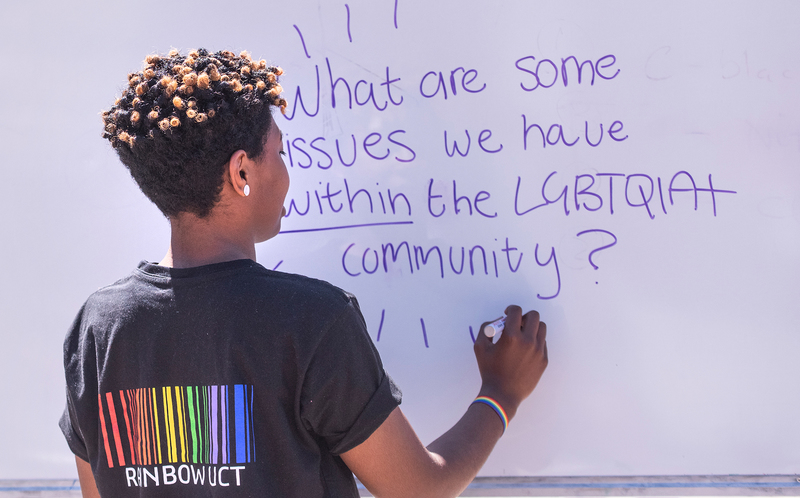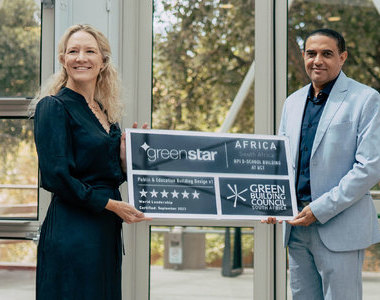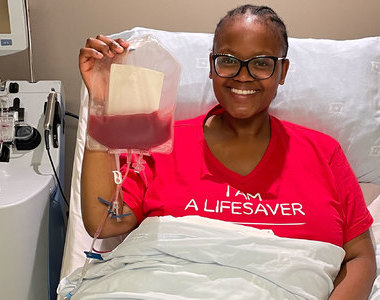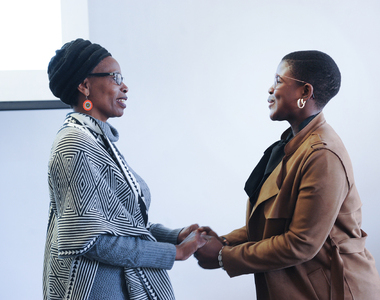Queerness and religion in conversation
14 October 2019 | Story Nadia Krige. Photo Brenton Geach. Read time 7 min.
Reconciling faith and queer identity can often be a difficult space to navigate for those who do not subscribe to the heteronormative expectations upheld by many religious communities.
Against this background, and in an effort to create safe and inclusive dialogue on the controversial topic, Rainbow UCT hosted a panel discussion titled “Queerness and Religion” last week, as part of this year’s Rainbow Week events at the University of Cape Town (UCT).
Representing a range of religious groupings, the panellists shared one commonality: their queer identity.
In conversation were Jacqui Benson, an activist and leader within Cape Town’s Jewish community, joined Hanzline Davids, process coordinator at Inclusive and Affirming Ministries (IAM) and a former minister in the Uniting Reformed Church in Southern Africa, and Upendra Naidoo, a third-year BSc student and outgoing religious representative of the Hindu Students’ Society at UCT.
Imam Muhsin Hendricks, founder of the People’s Mosque in Cape Town, was unable to take his place on the panel due to a prior commitment.
Rainbow UCT’s outreach coordinator Murray Hines facilitated the discussion, posing questions around the ways in which the panellists had experienced their religious and queer identities coming into conflict with one another.
“Queerness and religion are often seen as two separate spheres with religion tending toward queer phobia, and many queer people being anti-religious because of this,” he stated.
“Because religion can often be a place of strength for queer people, we wanted to find a way to unite those spheres for our religious members.”
“Queerness and religion are often seen as two separate spheres with religion tending toward queer phobia, and many queer people being anti-religious because of this.”
Representation of queerness in religion
He kicked off the discussion with a question around how queerness is depicted in the various religions represented by the panellists.
Benson and Davids both mentioned Leviticus 18:22 – an oft-cited verse in the third book of the Old Testament/Torah seeming to outlaw homosexuality.
“Just a little further on, there’s another verse stating that it’s considered sinful to wear clothing made from fabric in which cotton and linen have been mixed,” Benson pointed out. In the modern context, this “means if you’re wearing polyester – which most of us are – you’re a sinner”.
She expanded on this by stating that this book was written at a specific time for a specific purpose and that many of the laws are no longer relevant today.
Davids shared a similar view, explaining that at that specific time nation-building was key to the people of Israel and these types of laws were possibly intended to ensure reproduction.
“It’s a typical case of ideological frameworks becoming intertwined with religious frameworks,” he said.
From a Hindu perspective, Naidoo noted that the Vedic texts are awash with tales that could be viewed through a queer lens: women falling into ponds and emerging as men, deities switching genders to procreate with other deities, and mention of a “third gender”.
“In Hinduism there is space for everyone – no matter your identity,” he said.
While grappling with his own queer identity – especially societal expectations of how men should express their masculinity – Naidoo found particular solace in Ardhanarishvara, a composite androgynous form of the Hindu deities Shiva and his consort Parvati.
“There is a popular image of Ardhanarishvara with Shiva on the right and Parvati on the left,” he said.
“It resonated with me so much that I actually got a tattoo, because it made me feel comfortable with myself.”
Queer phobia in religious communities
Naidoo said he hadn’t been met with queer phobia as such – especially not in places of worship – most likely because of the inclusive nature of the Hindu faith.
“While there is no outright hatred of queerness, there have been instances where I’ve heard people chatter in the background about the identities of others.”
“While there is no outright hatred of queerness, there have been instances where I’ve heard people chatter in the background about the identities of others,” he said.
“But I think this largely comes from a place of ignorance.”
This is also a common occurrence in their own religious communities, agreed Davids and Benson, adding that in most cases, open conversations can help clarify any confusion people may have around queerness.
“Part of what we do at IAM is to develop contextual workshops where we can take faith leaders, clergy, laity and so forth into conversation with queer people,” Davids said.
“Instead of speaking about one another, they are given an opportunity to converse with one another.”
Facing religious hostility from the queer community
As Hines pointed out, religion and queer identity are often seen as two separate spheres that are inevitably at odds with one another. Because of this, queer people of faith tend to find themselves inhabiting a contentious space between where their religious identity is misunderstood by one side, and their queer identity by the other.
While it may be uncomfortable at first, Benson said, eventually it could become a space of empowerment as you help people understand each other better.
As an activist, she has made use of opportunities to address misunderstandings the Jewish community – especially the older generations – may have about queer people and, similarly, she’s been able to bring a new perspective to those within the queer community who may misunderstand her Jewish identity.
“I always find with people who have an issue with Judaism, it’s very much born out of reaction to past hurt,” she said.
“We need to just be cognisant of anybody who’s been burned by experiences like that and validate their personal experiences of religion.”
The three panellists all view their faith as deeply personal and intimate, and said that they hope the panel discussion might give fellow queer people some insight into religion that is kinder and less shaped by outside forces.
While this conversation has formed part of Rainbow Week in past years, Hines said he was pleased to see how much it has grown.
“It’s bigger than it’s ever been and more diverse than it’s ever been,” he said.
“It’s always really exciting to see different religions come together to converse.”
 This work is licensed under a Creative Commons Attribution-NoDerivatives 4.0 International License.
This work is licensed under a Creative Commons Attribution-NoDerivatives 4.0 International License.
Please view the republishing articles page for more information.
Listen to the news
The stories in this selection include an audio recording for your listening convenience.























































































































































































































































































































































































